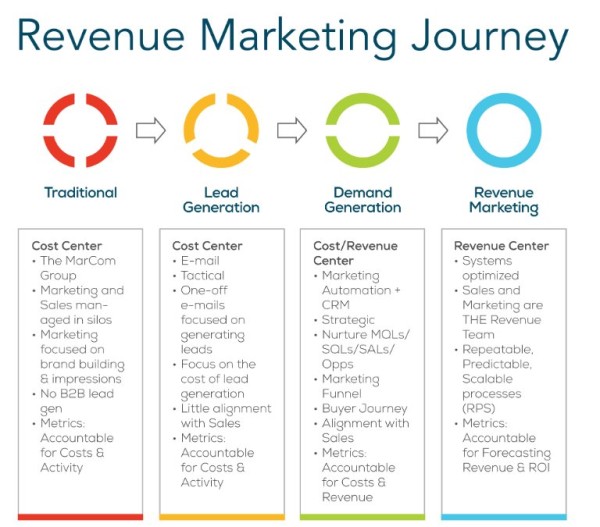Metrics That Matter are financially oriented metrics that executives can use to make business decisions. As you look at building your 2015 plan, you should also build it as a business case. This will help you focus on the NUMBERS in terms or revenue impact on the business. As you consider what you can and should be measuring in 2015, first consider where you are on the Revenue Marketing Journey and then take a good, hard look at Metrics That Matter to your executive board.
Where are you on the Revenue Marketing Journey?
Next, as we take a look at what we measure at each stage of the RMJ™, we can classify it into different types of reporting – Activity Reporting, Email Reporting, Funnel Reporting, and Funnel Forecasting.
The Metrics Progression
Activity Reporting
Activity reporting occurs in the Traditional stage. This type of reporting focuses on numbers related to activities in the aggregate and is not related to demand generation. Typical metrics include:
- # of events hosted per year
- # of registrants and attendees
- # of ads
- # of ad impressions
- # of press releases
E-Mail Reporting
E-mail reporting is highlighted in the Lead Generation stage and focuses on numbers related to activities. The hot new metric is how many “leads” marketing produces for sales. The definition of a lead is fuzzy and is often a marketing determined definition. Typical metrics include:
- % and # of opens and click-throughs
- % and # of bounces
- % and # of form completions (a conversion)
- # of “leads” sent to sales
- Cost per lead
Funnel Reporting
Funnel reporting begins to occur in the Demand Generation stage of Revenue Marketing and is focused on pipeline and revenue-related metrics. This type of reporting represents a high level of measurement competence and is fairly sophisticated. It is this type of reporting that we see begins to mark a significant change in marketing as it relates to revenue and company-wide credibility. Typical metrics include:
- # of MQLs, SALs, SQLs
- Conversion rates of each of the above
- % and $ contribution to pipeline/closed business from marketing
- Average Deal Size from an MQL
- Average Days to Close from an MQL
Funnel Forecasting
Funnel Forecasting is when your Revenue Marketing practice is now driving repeatable, predictable, and scalable revenue (RPS) which means marketing can now forecast their impact in revenue, just like sales. Typical metrics include:
- Forecast for pipeline and revenue
- Forecast variability
- Conversion rates
- Conversion variability
As you look at 2015, consider what you will be responsible for in terms of revenue. As a marketer, this is becoming an increasingly important part of the job…and it’s not going to go away.
What and how will you measure financial performance of marketing in 2015? I’d love to hear what will be key for you!
Business Articles | Business 2 Community
(461)





